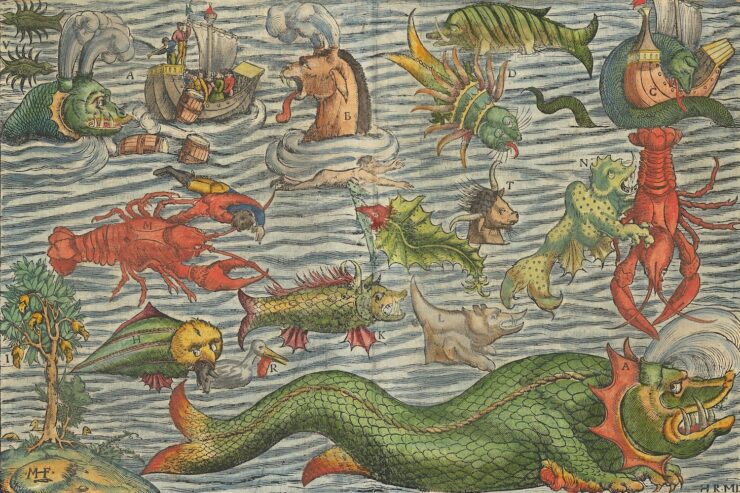Previous chapters of the Bestiary have been mostly linear. I’ve organized them by categories and species and locations. Now that we’re headed out to sea, I’d like to be more free-form. Let’s go where the tides of whim and research take us.
My definition of “monster” here is broad. It can be mythical or legendary, but it can be real, too. It can be very large or very unusual or downright weird. Maybe we’ve known about it forever. Maybe we thought it was mythical, until it turned up onshore or in a net or on a deep-water cam. Maybe it’s new to science.
Humans can get kind of full of themselves. Pinnacle of creation, top of the animal kingdom, most intelligent, Man The Toolmaker. We’ve certainly left our mark on the planet. We can get to thinking we rule the world.
Even the land never fails to surprise us, and we know considerably more about it than we do about the ocean. It’s 70% of the earth’s surface. Its average depth is around 3600 meters (12,000 feet). We’ve mapped about a quarter of the sea floor, but we’ve barely begun to explore what’s down there.
For a science fiction or fantasy writer, the ocean is a source of endless inspiration. The sheer range and variety of sea life is boggling. It’s amazing enough in the shallows we’re most familiar with, but the deeper you go, the weirder it gets. There are things down there that are as alien as anything you can find on a science-fictional world. But they’re right here, on our planet.
I’ll be looking at all kinds of sea creatures, from the whale and its relatives to the sea snake to the seahorse to the many forms of the jellyfish, to the eerie beauty of siphonophores, to all the myriad kinds and shapes of fish, to corals and sponges and sea stars, to the octopus and the squid and the Kraken that’s half a myth and half reality. Let’s not forget the great movie monsters, either, beginning with Godzilla.
What’s your favorite sea creature? It can appear in a book or a film or a TV series. Or it can be in a scientific study, a new species or one that’s revealed new facets of itself. The possibilities are endless. I won’t pretend to be able to talk about them all, but we can have some fun exploring the wonders of the seven seas.











Favorite? Dolphins and Porpoises, especially the larger Orcas. Seeing dolphins up close while surfing was always cool, although finding out that the males are very sexually aggressive (and not just to female dolphins) has made me a bit warier. I suspect some of Anne McCaffrey’s Pern books would have been a bit different if she’d known that.
Orcas, lately, have been pretty interesting, especially as they have various cultures and are highly intelligent. Recently some have taken to eating just the livers of sharks. Others are “playing” with yachts off of Gibraltar. Wonder what they did when we weren’t looking everywhere?
Favorite -Octopuses.
In a novel – The octopus civilization on a terraformed water world in Adrian Tchaikovsky’ Children of Ruin.
I like the Oarfish, it seems like it has mythological significance as well as being generally weird and fascinating! But I really love any sea monster, I’ve been obsessed with them since I was a kid. Lion’s Man Jellyfish and the Portugese Man of War Jellyfish are also pretty interesting… On the fiction front, Junji Ito did a story about people who were swallowed by a giant deep sea fish and carried in its see-through stomach, and they witnessed such horrors in the deep ocean that they were all driven mad. That was a fun one.
I’m fascinated by the really deep ocean creatures you can see in videos mostly taken by remote controlled submersibles, not all of which even have names yet. There’s a fish that has a tripod to lurk above deep mud, an octopus with really, really skinny arms that look as if they’re metres long, all the creatures that feed on whale fall and so many more.
I’m a Scot who happens to be the child of a professional diver. I have a long fascination with our myths of the selkie. For the more mundane, turtle and octopus, the first incredibly instinctual and the second incredibly smart.
A fairly comprehensive (if woefully outdated) guide to sea monsters is Bernard Heuvelmans’ In the Wake of the Sea Serpents. A comprehensive worldwide survey of sea monster sightings up until 1969, and the first attempt a classification of the different types and assign possible identities to them.
Heuvelmans did a thorough job of assembling all of the data available at the time he published. However, in the ensuing decades, a lot of his data and conclusions have been invalidates by subsequent workers. And of course, we still don’t have a carcass.
Of today’s known sea monsters, my favourite has to be the leatherback sea turtle. A warm-blooded (effectively) sea turtle as long as a small car and weighing over half a tonne, that crosses oceans from continent to continent – great stuff.